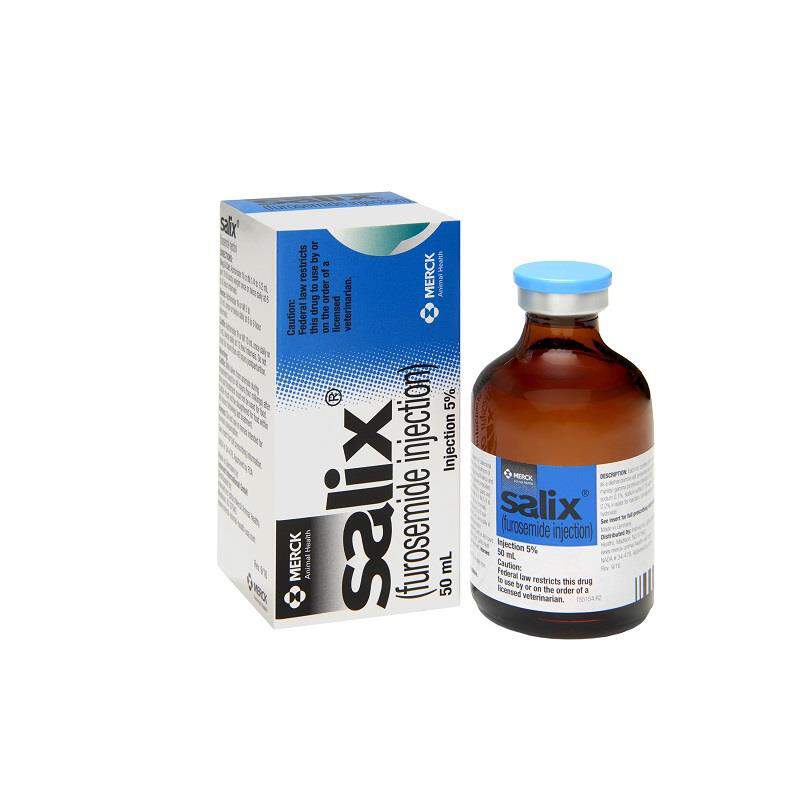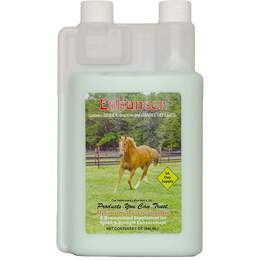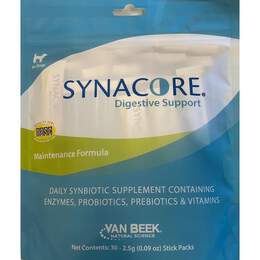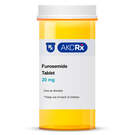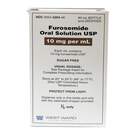

Click on image to open expanded view
Item No.
25409
Product Description
Salix Injectable (50 mg/ml) 50 ml vial is an effective diuretic possessing a wide therapeutic range. Pharmacologically it promotes the rapid removal of abnormally retained extracellular fluids. The rationale for the efficacious use of diuretic therapy is determined by the clinical pathology producing the edema.
What is Salix Injectable (50 mg/ml) 50 ml vial?
Salix Injectable (50 mg/ml) 50 ml vial is an effective diuretic for dogs, cats & horses. Salix has a wide therapeutic range and is often used to treat edema (pulmonary congestion, ascites) associated with carida insufficiency and acute noninflammatory tissue edema. In cattle Salix is used to treat physiological parturient edema of the mammary gland associated structures.
Who is Salix Injectable (50 mg/ml) 50 ml vial for?
Dogs, Cats, Horses & Cattle
Why use Salix Injectable (50 mg/ml) 50 ml vial?
-A diuretic-saluretic for prompt relief of edema.
-A high degree of efficacy, low-inherent toxicity and a high therapeutic index.
-A rapid onset of action and of comparatively short duration.
How does Salix Injectable (50 mg/ml) 50 ml vial work?
The therapeutic efficacy of Salix® is from the activity of the intact and unaltered molecule throughout the nephron, inhibiting the reabsorption of sodium not only in the proximal and distal tubule but also in the ascending limb of the loop of Henle.
Manufacturer:
Merck Animal Health.
Active Ingredients(s):
Furosemide
How is Salix Injectable (50 mg/ml) 50 ml vial sold?
50 mg/ml, 50 ml vial
What are the side effects of Salix Injectable (50 mg/ml) 50 ml vial?
Increased thirst and increased urination. Furosemide is associated with an increase in blood sugar levels. This is not a problem for most patients but a different diuretic may be a better choice for a diabetic patient. Hearing loss has been reported, especially in cats, when large amounts of injectable lasix have been used in a crisis.
What special precautions are there?
Salix® is a highly effective diuretic and if given in excessive amounts as with any diuretic may lead to excessive diuresis which could result in electrolyte imbalance, dehydration and reduction of plasma volume enhancing the risk of circulatory collapse, thrombosis, and embolism. Therefore, the animal should be observed for early signs of fluid depletion with electrolyte imbalance, and corrective measures administered. Excessive loss of potassium in patients receiving digitalis or its glycosides may precipitate digitalis toxicity. Caution should be exercised in animals administered potassium-depleting steroids.
What to do if overdose?
If overdose contact your nearest pet hospital immediately.
How can I store Salix Injectable (50 mg/ml) 50 ml vial?
Store between 59° and 86° F. Protect from freezing.
Helpful Tips:
Excessive loss of potassium in patients receiving digitalis or its glycosides may precipitate digitalis toxicity. Caution should be exercised in animals administered potassium-depleting steroids.
It is important to correct potassium deficiency with dietary supplementation. Caution should be exercised in prescribing enteric-coated potassium tablets.
Overview
The usual dosage of Salix® is 1 to 2 mg/lb. body weight (approximately 2.5 to 5 mg/kg). The lower dosage is suggested for cats. Administer once or twice daily at 6 to 8 hour intervals either orally, intravenously, or intramuscularly. A prompt diuresis usually ensues from the initial treatment. Diuresis may be initiated by the parenteral administration of Salix® Injection and then maintained by oral administration.
The dosage should be adjusted to the individual's response. In severe edematous or refractory cases, the dose may be doubled or increased by increments of 1 mg per pound body weight. The established effective dose should be administered once or twice daily. The daily schedule of administration can be timed to control the period of micturition for the convenience of the client or veterinarian. Mobilization of the edema may be most efficiently and safely accomplished by utilizing an intermittent daily dosage schedule, i.e., every other day or 2 to 4 consecutive days weekly.
Diuretic therapy should be discontinued after reduction of the edema, or maintained after determining a carefully programmed dosage schedule to prevent recurrence of edema. For long-term treatment, the dose can generally be lowered after the edema has once been reduced. Re-examination and consultations with client will enhance the establishment of a satisfactorily programmed dosage schedule. Clinical examination and serum BUN, CO2 and electrolyte determinations should be performed during the early period of therapy and periodically thereafter, especially in refractory cases. Abnormalities should be corrected or the drug temporarily withdrawn.
DOSAGE: ORAL
DOG AND CAT - One-half to one 50 mg scored tablet per 25 pounds body weight.
One 12.5 mg tablet per 5 to 10 pounds body weight.
Administer once or twice daily, permitting a 6 to 8 hour interval between treatments. In refractory or severe edematous cases, the dosage may be doubled or increased by increments of 1 mg per pound body weight as recommended in preceding paragraphs, "Dosage and Administration".
PARENTERAL:
DOG AND CAT - Administer intramuscularly or intravenously 1/4 to 1/2 mL per 10 pounds body weight.
Administer once or twice daily, permitting a 6 to 8 hour interval between treatments. In refractory or severe edematous cases, the dosage may be doubled or increased by increments of 1 mg per pound body weight as recommended in preceding paragraphs, "Dosage and Administration".
HORSE - The individual dose is 250 to 500 mg (5 to 10 mL) administered intramuscularly or intravenously once or twice daily at 6 to 8 hour intervals until desired results are achieved. The veterinarian should evaluate the degree of edema present and adjust dosage schedule accordingly. Do not use in horses intended for human consumption.
CATTLE - The individual dose administered intramuscularly or intravenously is 500 mg (10 mL) once daily or 250 mg (5 mL) twice daily at 12 hour intervals. Treatment not to exceed 48 hours postparturition.
Milk taken from animals during treatment and for 48 hours (four milkings) after the last treatment must not be used for food. Cattle must not be slaughtered for food within 48 hours following last treatment.
Main Ingredients
Salix® (furosemide) Injection 5% Each mL contains: 50 mg furosemide as a diethanolamine salt preserved and stabilized with myristyl-gamma-picolinium chloride 0.02%, EDTA sodium 0.1%, sodium sulfite 0.1% with sodium chloride 0.2% in distilled water, pH adjusted with sodium hydroxide.

